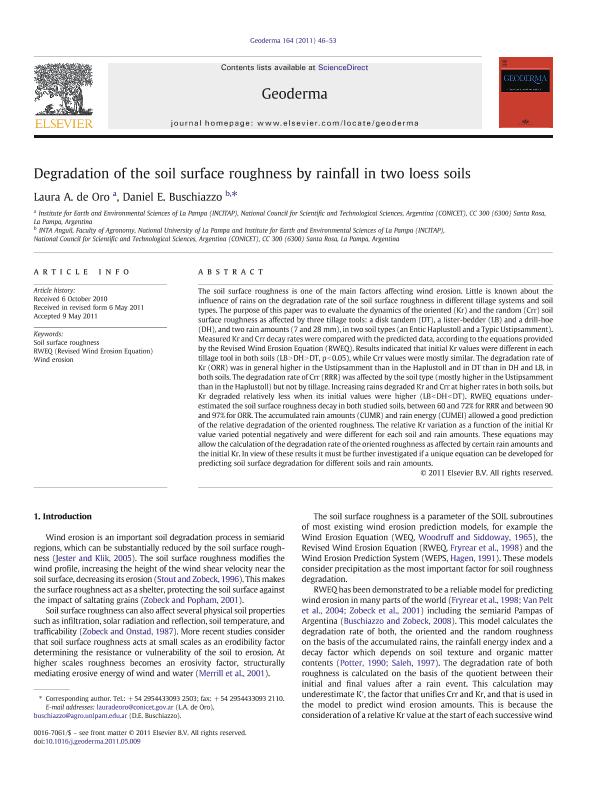Mostrar el registro sencillo del ítem
dc.contributor.author
de Oro, Laura Andrea

dc.contributor.author
Buschiazzo, Daniel Eduardo

dc.date.available
2019-08-14T20:27:15Z
dc.date.issued
2011-08
dc.identifier.citation
de Oro, Laura Andrea; Buschiazzo, Daniel Eduardo; Degradation of the soil surface roughness by rainfall in two loess soils; Elsevier Science; Geoderma; 164; 1-2; 8-2011; 46-53
dc.identifier.issn
0016-7061
dc.identifier.uri
http://hdl.handle.net/11336/81605
dc.description.abstract
The soil surface roughness is one of the main factors affecting wind erosion. Little is known about the influence of rains on the degradation rate of the soil surface roughness in different tillage systems and soil types. The purpose of this paper was to evaluate the dynamics of the oriented (Kr) and the random (Crr) soil surface roughness as affected by three tillage tools: a disk tandem (DT), a lister-bedder (LB) and a drill-hoe (DH), and two rain amounts (7 and 28. mm), in two soil types (an Entic Haplustoll and a Typic Ustipsamment). Measured Kr and Crr decay rates were compared with the predicted data, according to the equations provided by the Revised Wind Erosion Equation (RWEQ). Results indicated that initial Kr values were different in each tillage tool in both soils (LB > DH > DT, p < 0.05), while Crr values were mostly similar. The degradation rate of Kr (ORR) was in general higher in the Ustipsamment than in the Haplustoll and in DT than in DH and LB, in both soils. The degradation rate of Crr (RRR) was affected by the soil type (mostly higher in the Ustipsamment than in the Haplustoll) but not by tillage. Increasing rains degraded Kr and Crr at higher rates in both soils, but Kr degraded relatively less when its initial values were higher (LB < DH < DT). RWEQ equations underestimated the soil surface roughness decay in both studied soils, between 60 and 72% for RRR and between 90 and 97% for ORR. The accumulated rain amounts (CUMR) and rain energy (CUMEI) allowed a good prediction of the relative degradation of the oriented roughness. The relative Kr variation as a function of the initial Kr value varied potential negatively and were different for each soil and rain amounts. These equations may allow the calculation of the degradation rate of the oriented roughness as affected by certain rain amounts and the initial Kr. In view of these results it must be further investigated if a unique equation can be developed for predicting soil surface degradation for different soils and rain amounts.
dc.format
application/pdf
dc.language.iso
eng
dc.publisher
Elsevier Science

dc.rights
info:eu-repo/semantics/openAccess
dc.rights.uri
https://creativecommons.org/licenses/by-nc-nd/2.5/ar/
dc.subject
Rweq (Revised Wind Erosion Equation)
dc.subject
Soil Surface Roughness
dc.subject
Wind Erosion
dc.subject.classification
Otras Ciencias Agrícolas

dc.subject.classification
Otras Ciencias Agrícolas

dc.subject.classification
CIENCIAS AGRÍCOLAS

dc.title
Degradation of the soil surface roughness by rainfall in two loess soils
dc.type
info:eu-repo/semantics/article
dc.type
info:ar-repo/semantics/artículo
dc.type
info:eu-repo/semantics/publishedVersion
dc.date.updated
2019-08-13T19:14:10Z
dc.journal.volume
164
dc.journal.number
1-2
dc.journal.pagination
46-53
dc.journal.pais
Países Bajos

dc.journal.ciudad
Amsterdam
dc.description.fil
Fil: de Oro, Laura Andrea. Consejo Nacional de Investigaciones Científicas y Técnicas. Instituto de Ciencias de la Tierra y Ambientales de La Pampa. Universidad Nacional de La Pampa. Facultad de Ciencias Exactas y Naturales. Instituto de Ciencias de la Tierra y Ambientales de La Pampa; Argentina
dc.description.fil
Fil: Buschiazzo, Daniel Eduardo. Consejo Nacional de Investigaciones Científicas y Técnicas. Instituto de Ciencias de la Tierra y Ambientales de La Pampa. Universidad Nacional de La Pampa. Facultad de Ciencias Exactas y Naturales. Instituto de Ciencias de la Tierra y Ambientales de La Pampa; Argentina. Instituto Nacional de Tecnología Agropecuaria. Centro Regional La Pampa-San Luis. Estación Experimental Agropecuaria Anguil; Argentina
dc.journal.title
Geoderma

dc.relation.alternativeid
info:eu-repo/semantics/altIdentifier/url/https://www.sciencedirect.com/science/article/pii/S0016706111001315
dc.relation.alternativeid
info:eu-repo/semantics/altIdentifier/doi/https://doi.org/10.1016/j.geoderma.2011.05.009
Archivos asociados
